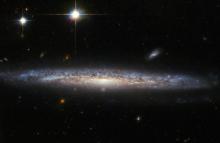Spiral galaxy
Euclid space telescope unveils new images of the cosmos
This handout image obtained on May 23, 2024 courtesy of NASA/ESA/CSA shows space telescope Euclid's new view of Messier 78 (the central and brightest region), a vibrant nursery of star formation enveloped in a shroud of interstellar dust, from a series of new images taken by space telescope Euclid
Webb telescope captures colorful Cartwheel Galaxy
The James Webb Space Telescope has peered through time and huge amounts of dust to capture a new image of the Cartwheel Galaxy, revealing the spinning ring of color in unprecedented clarity, NASA and the European Space Agency said on Aug. 2.
- Read more about Webb telescope captures colorful Cartwheel Galaxy
- Log in to post comments
Rights violations result in 207 deaths in Turkey in September – Report
Going further down the spiral…
Milky Way Still Bears the 10-billion-year-old Scars of a Galactic Collision
Galaxies collide with each other on a pretty regular basis. Our own Milky Way, for instance, has gobbled up dozens of smaller galaxies in the past, and Andromeda is currently hurtling towards us at 109 km (68 mi) per second.
NASA Showed a Galaxy at 130 Million Light-years from Earth
US Space Agency NASA published a photo of spiral galaxy NGC 5714 in the Volovar constellation. It is about 130 million light-years from our planet.
The image of NGC 5714 is made with the Hubble Space Telescope with the ACS camera.
Hubble captures massive dead disk galaxy that challenges theories of galaxy evolution
By combining the power of a “natural lens” in space with the capability of NASA’s Hubble Space Telescope, astronomers made a surprising discovery—the first example of a compact yet massive, fast-spinning, disk-shaped galaxy that stopped making stars only a few billion years after the big bang.





